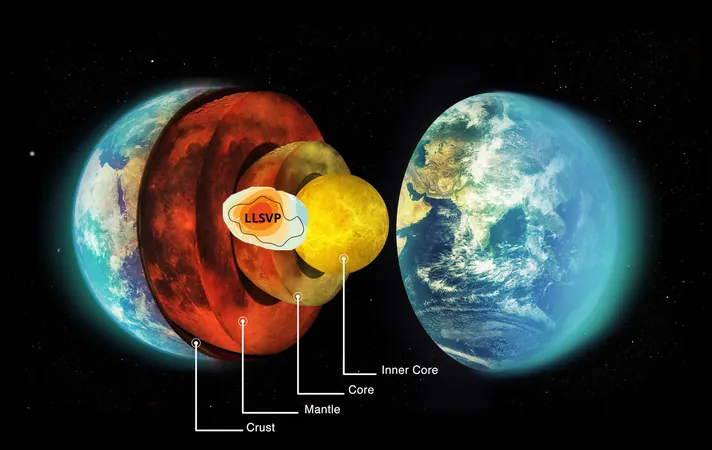
Massive, Hidden "Islands" in Earth's Mantle Challenge Our Understanding of Geology
2025-01-26
Author: Ken Lee
Scientists have made groundbreaking revelations about two enormous, continent-sized regions located deep within Earth's mantle, deemed "islands." A recent study from Utrecht University has unveiled that these regions are not only significantly hotter than the surrounding mantle but also trace their origins back at least half a billion years.
This discovery calls into question the long-standing beliefs regarding the Earth's mantle being a uniform system characterized by constant mixing and flow. The findings suggest a much more complex scenario, indicating less fluidity in the mantle than previously theorized.
The Hidden Islands Beneath Our Feet
Situated approximately 1,200 miles (2,000 km) below the Earth’s surface and reaching impressive heights of around 620 miles (1,000 km), these hidden islands dwarf Mount Everest — the tallest mountain on the planet. The two regions of interest lie beneath Africa and the Pacific Ocean and were first detected in the late 20th century through extensive seismic studies.
When major earthquakes occur, they send shockwaves through the Earth, causing it to resonate, akin to a bell. Researchers have utilized this resonance to identify these extraordinary subsurface structures, referred to as Large Low Seismic Velocity Provinces (LLSVPs).
The Mystery of the LLSVPs
Despite extensive research, the exact nature and age of LLSVPs remain elusive. Arwen Deuss, a leading seismologist at Utrecht University, expressed that scientists are still uncertain if these regions are temporary formations or if they have persisted for millions or even billions of years. Surrounding these islands is a "graveyard" of cold, dense tectonic plates that have sunk to these depths through the subduction process, where one tectonic plate sinks beneath another.
Scientists have discovered that seismic waves travel more slowly through the LLSVPs than they do in the less stable regions, indicating significant geological differences within Earth’s structure.
Unique Properties and Implications
A deeper analysis led by Deuss and her colleague Sujania Talavera-Soza revealed surprising results. They focused not only on how seismic waves slow down in the LLSVPs but also measured "damping," or energy loss of the waves during their travel through the Earth. Surprisingly, they found minimal damping in these hot islands, where seismic waves were notably louder, while the cold slab graveyards showed significant energy loss.
This inconsistency hints at distinctive material properties within the LLSVPs. Studies suggest that the regions consist of larger mineral grains, allowing seismic waves to move through without significant loss of energy. This trait implies that the LLSVPs have remained largely unchanged for extensive periods, contrasting with the dynamic, constantly recycling materials usually found in the rest of the mantle.
Understanding Earth's Evolution
These findings carry significant implications for our understanding of Earth's evolution. The rigidity and age of the LLSVPs suggest that they have resisted the mantle's convection processes, a notion that disrupts previous ideas about a uniformly mixed mantle. According to Talavera-Soza, "The LLSVPs must survive mantle convection somehow," highlighting the complexity of these regions.
Earth's mantle plays a critical role in surface phenomena like volcanism and mountain formation. Mantle plumes, which are columns of hot molten material rising from the depths of the Earth, are believed to originate near the edges of LLSVPs. These plumes can lead to volcanic activities, such as those seen in Hawaii.
Future Insights Through Seismology
Studying these intriguing "islands" requires sophisticated seismology techniques. Researchers utilize the seismic waves produced by deep-focus earthquakes, for instance, the Bolivia earthquake in 1994, which occurred at depths exceeding 650 km and fortunately did not result in surface damage.
The revelations regarding the LLSVPs are reshaping our understanding of the Earth's mantle. Rather than a uniform, well-mixed system, what lies beneath us comprises ancient, stable structures that are crucial to interpreting surface geological activity.
This research not only advances our knowledge of Earth's interior dynamic processes but also emphasizes the mantle's role as the driving force behind many surface phenomena. The unique characteristics of the LLSVPs mark a significant step in geosciences, paving the way for further investigations into the complexities of our planet.
Stay tuned for more groundbreaking science updates as researchers continue to explore the hidden depths of our Earth!

 Brasil (PT)
Brasil (PT)
 Canada (EN)
Canada (EN)
 Chile (ES)
Chile (ES)
 Česko (CS)
Česko (CS)
 대한민국 (KO)
대한민국 (KO)
 España (ES)
España (ES)
 France (FR)
France (FR)
 Hong Kong (EN)
Hong Kong (EN)
 Italia (IT)
Italia (IT)
 日本 (JA)
日本 (JA)
 Magyarország (HU)
Magyarország (HU)
 Norge (NO)
Norge (NO)
 Polska (PL)
Polska (PL)
 Schweiz (DE)
Schweiz (DE)
 Singapore (EN)
Singapore (EN)
 Sverige (SV)
Sverige (SV)
 Suomi (FI)
Suomi (FI)
 Türkiye (TR)
Türkiye (TR)
 الإمارات العربية المتحدة (AR)
الإمارات العربية المتحدة (AR)